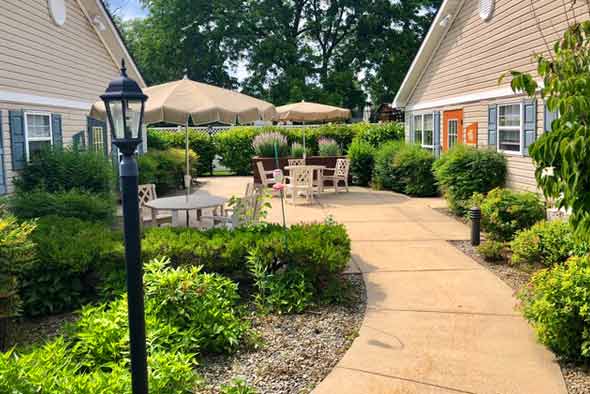
The Benefits of Access to the Great Outdoors for those with Dementia
By: Cate McCarty, PhD, ADC

The history of the Arden Courts name goes back to Shakespeare’s play, As You Like It where the Arden forest was a place to come to your true nature, to heal from the world’s demands. For over twenty years, the researched design of Arden Courts has offered healing and a return to true self for countless individuals living with dementia.
Over 20 years ago, dementia knowledge was much more of a forest than it is today. There were approximately eight identified types of dementia. Now, there are over 99 types identified. Arden Courts became the leader in educating caregivers in care strategies as well as the premier research-designed memory care community. In 20 years, the design has not waivered. The safe and secure indoor/outdoor walking paths offer the same freedom that Shakespeare wrote in As You Like It’s Arden. They beckon community members to a happier and calmer space.
It is said imitation is the best compliment. Now, there are other memory care communities boasting similar design to Arden Courts. However, rarely do they have the indoor/outdoor walking paths Arden Courts has. Often other communities feature a small courtyard with one seating area, very little exposure to nature and no continuous walking path.
Arden Courts understands the direction of the path an individual with dementia takes which has resulted in the best blend of internal and external environment in a seemingly continuous loop which fails to feel redundant or deceptive.
Research suggests that from 60-70% of individuals with dementia will wander.1A percentage of these individuals are looking for an outdoor connection. Research found that nature often provides a calming effect for individuals with dementia.2 When agitation includes pacing, being outdoors can be the solution if the space accessed includes variety, safety and security. The best environmental design for persons living with dementia include gathering spaces, diversity in nature and seating areas as universal design strategies for communities3.
Behavioral changes may dictate the outdoor connection. Several studies show being outdoors provides both physical and psychological health benefits to individuals living with dementia. Not only is Vitamin D readily accessible4, so are feelings of well-being and self-worth.5 In fact, elders who do not participate in outdoor activity have a decrease in cognitive function.6,8 In another study with individuals in the early stages of dementia, the freedom to go outdoors was of greatest value to the individual stating it was a confirmation of self.7
Care companions found enjoying nature was an important motivator for physical activity. Another motivator is the benefit of Vitamin D.8 If you are caring for someone living with dementia, schedule a walk at Arden Courts and experience the freedom as well as the security and safety of finding your true nature alongside theirs.
By-line: Cate McCarty, PhD, ADC has been collaborating with Arden Courts in a variety of roles since the late 90’s. Her background in nursing, activities and admissions has given her a passionate commitment to quality of life for the individual and family with dementia. Cate is now personally caring for her spouse who has a diagnosis of dementia of the Alzheimer’s type.
Footnotes
1https://www.alzinfo.org
2Eggert, J., Dye, C. J., Vincent, E., Parker, V., Daily, S.B., et al. (2015). Aug 31:3, Effects of viewing a preferred nature image and hearing preferred music on engagement, agitation, and mental status in persons with dementia, Sage Open Medicine.
3 York, S. L. (2009). Residential design and outdoor area accessibility, Neuro Rehabilitation, 25(3):201-208.
4 Licher, S., de Bruijin, R., Wolters, F. J., Zillikens, M. C., Ikram, et al. (2017). Vitamin D and the risk of dementia: The Rotterdam study, Journal of Alzheimer’s Disease, 60(3):989-997.
5Olsson, A., Lampic, C., Skovdahl, K., & Engstrom, M. (2013). Persons with early-stage dementia reflect on being outdoors: a repeated interview study, Aging and Mental Health, 17(7): 793-800.
6Harada, K., Lee, S., Park ,H,. Shimada, H., Makizako ,H., et al. (2016). Going outdoors and cognitive function among community-dwelling older adults: Moderating role of physical function, Geriatric Gerontology International, 16(1): 65-73.
7Cedervall, Y., & Aberg, A.C. (2010). Physical activity and implications on well-being in mild Alzheimer’s disease: A qualitative case study on two men with dementia and their spouses, Physiotherapy Theory & Practice,26(4): 226-239.
8Suzuki, T., & Murase, S. (2010). Influence of outdoor activity and indoor activity on cognitive decline: Use of an infrared sensor to measure activity, Telemedicine Journal of E-Health,16(6): 686-


